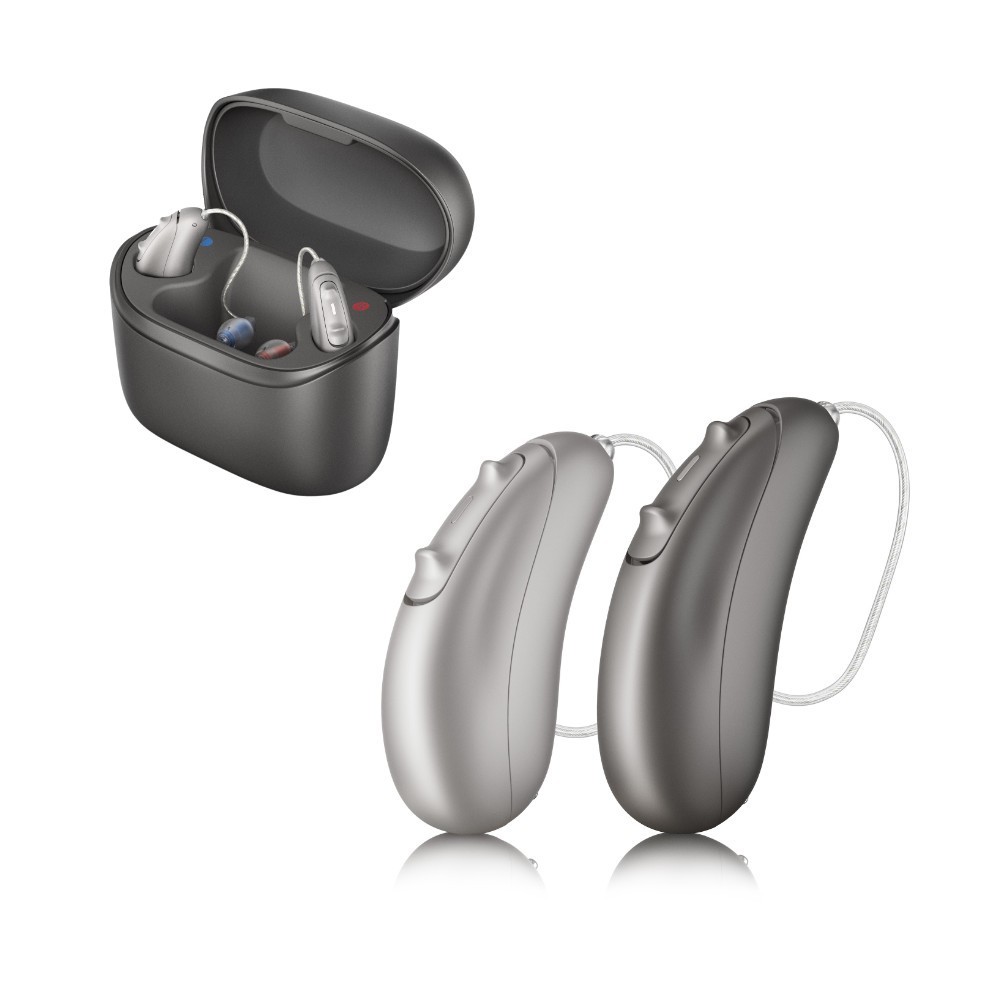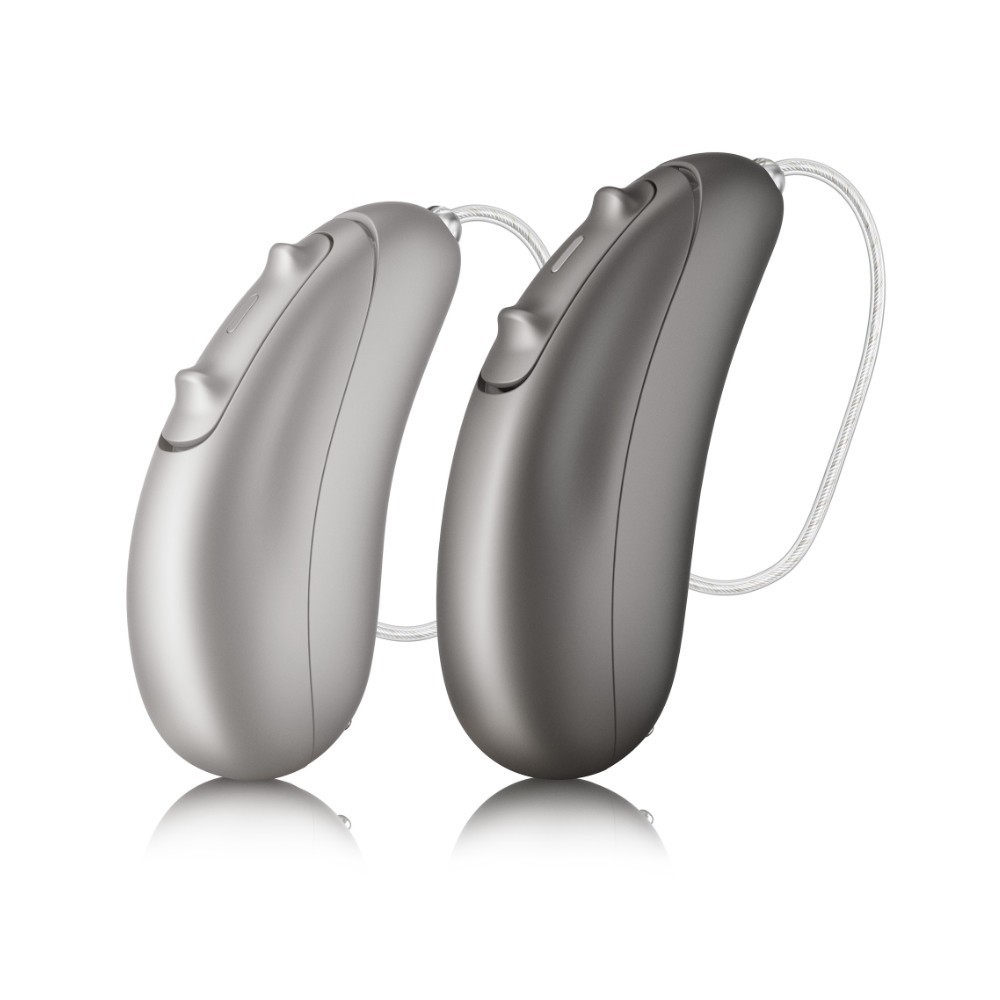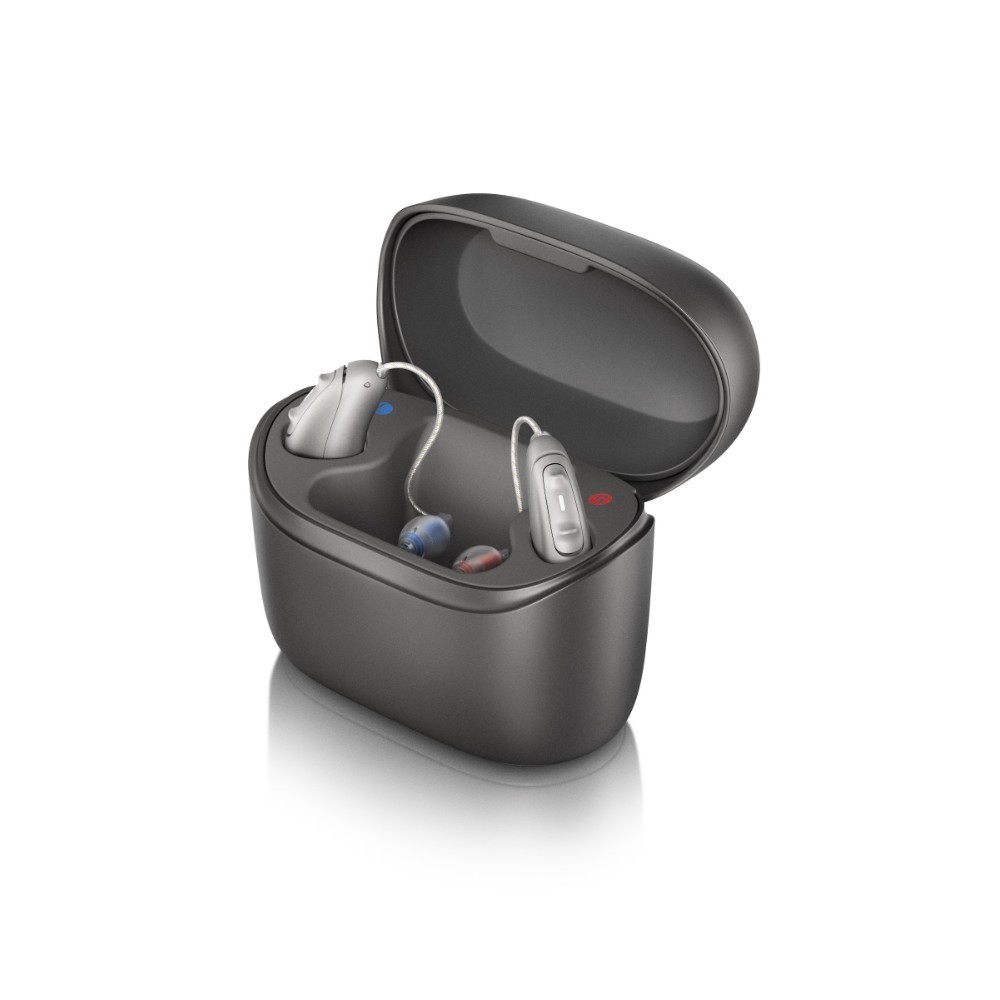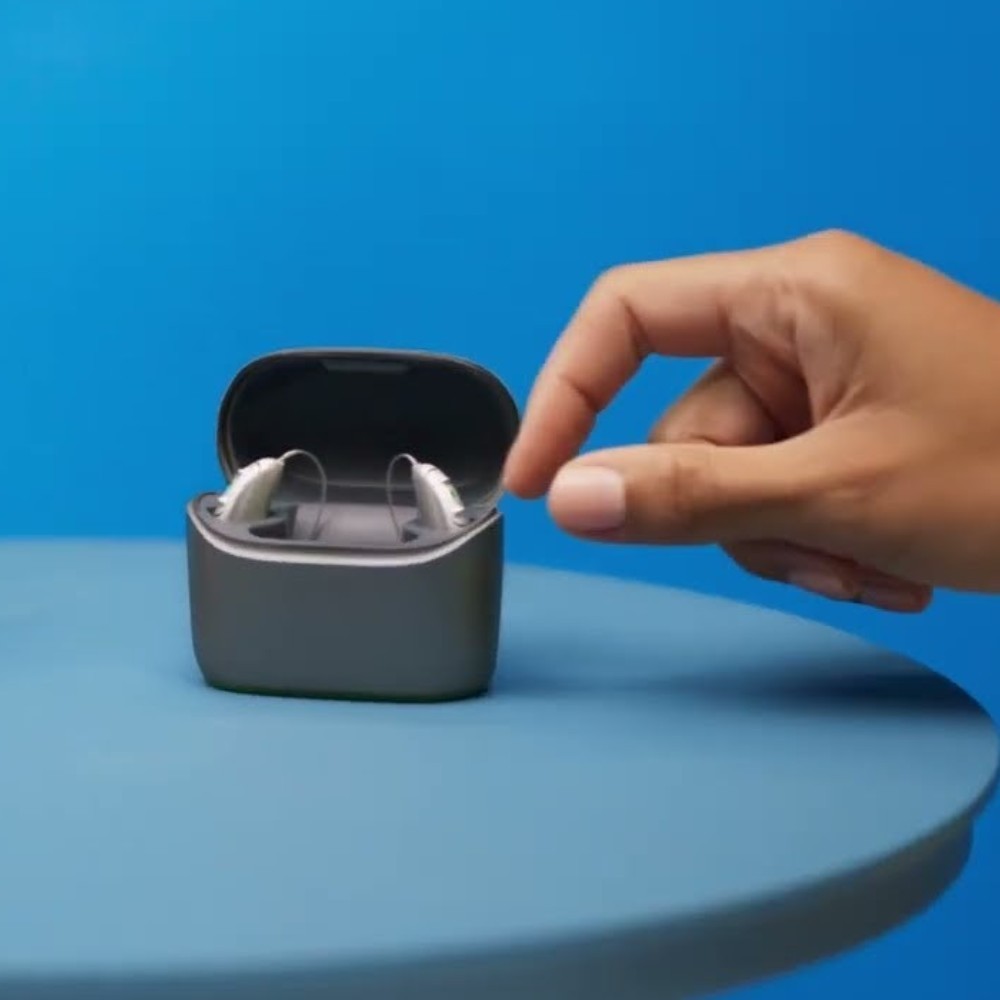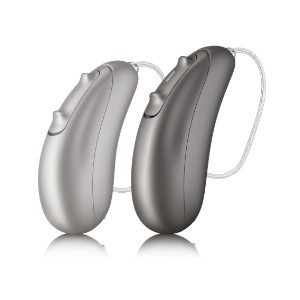Fitting Styles: RIC
Warranty: 5 years
Charger: Rechargeable comes at no extra cost

What's included in our hearing aid prices?
Details & Features
Unitron Vivante Moxi V7 Hearing Aids Overview
Unitron Vivante Moxi V7 hearing aids are the advanced performance in this hearing aid range, which means you will miss out on the more sophisticated features that focus on speech in all directions in noisy conversations, loud noise, and in the car. These are included in the Unitron Vivante Moxi V9 performance level. View this level and full feature set here
However, you will benefit from a better focus on speech coming from both the front and sides in challenging listening situations in 6 environments. There is also an automatic music and car program for these particular environments. This will support the focus on speech coming from one location.
In regards to the sound performance of the Unitron Vivante Moxi V7 hearing aids, using the Pinna Effect 2 the cues you typically lose with hearing aids, which are needed for localisation, are compensated for with Unitron's binaural microphone mode.
Main features
Hearing aid technology that will improve quiet and challenging conversations
Automatic programs for 6 environments:
- Conversation in Quiet
- Conversation in Noise
- Conversation in a Small Group
- Music
- Quiet
- Noise
Manual programs:
- Conversation in Loud Noise
- Car with Speech
Integra OS automation system
This system combines powerful binaural communication and automatic optimisation of your sound performance in high and low-complexity listening environments. This ultimately reduces the impact of those typically lost acoustic cues when wearing hearing aids. Integra OS uses soft speech lift to make the subtle nuances of speech more pronounced.
Moxi V7 AutoFocus
- Speech from front
AutoFocus identifies speech then focuses and increases speech from the front. Dynamic noise reduction is also active and can be adjusted to reduce background noise even further.
- Speech from side and back
AutoFocus uses a wide front beam to identify and capture speech partially from the sides
Hearing aid models available
- Moxi V7-R: A rechargeable lithium-ion battery hearing aid with a push-button, IP 68 rating, and Bluetooth connectivity. Available in a platinum casing.
- Moxi V7-RT: A rechargeable lithium-ion battery hearing aid with a push-button, IP 68, Bluetooth connectivity, and telecoil. Available in a platinum casing.
- Moxi V7-312: Small traditional 312-battery RIC hearing aid.
Connectivity
This is a Made for All hearing aid and includes hands-free technology, connectivity to two Bluetooth devices at the same time, and compatibility with Unitron's accessories. Such as Remote Control, PartnerMic, TV Connector, and Roger Direct.
►Click here to visit the Unitron Vivante hearing aid range page
Want to know more about the Vivante Moxi V7 hearing aids?
Call us free on 0800 567 7621 to speak with one of our audiologists about the Unitron Vivante Moxi V7 digital hearing aids and whether they are right for your hearing loss needs.
►Click here to go back to the top of the page
Other performance levels in the Unitron Vivante Moxi hearing aid range:
►Unitron Vivante Moxi V9 hearing aids
►Unitron Vivante Moxi V5 hearing aids
►Unitron Vivante Moxi V3 hearing aids
**Please note, there will be an additional surcharge of £125 if we are pairing a single hearing aid with an existing aid bought from another company where we are taking over the aftercare responsibilities and looking after both hearing aids**
Unitron Vivante Moxi Hearing Aids Information
Click on the buttons to find out moreWatch the Unitron Vivante Moxi Hearing Aid Video Below
Have any questions?
Here, at Hearing Aid UK, we offer a wide range of hearing aids available on the market - keeping up to date with the best and latest hearing aid technology.
We can support your hearing healthcare in clinic or in the comfort of your own home and with nationwide coverage, we will have an audiologist near you.
Whatever your hearing loss level, budget, or style our audiologists can help you find the perfect hearing solution for you.
Call us free for support and advice on 0800 567 7621
Our specialist service includes:
Do not spend hundreds of pounds without getting a second opinion from us.
Please call us on 0800 567 7621
 Not only are the prices great, but the service is fantastic! Many thanks to your team.
Not only are the prices great, but the service is fantastic! Many thanks to your team.Other pages you might find useful
What's included in our hearing aid prices?
FAQs
In general, any audiologist will always recommend to you the hearing aid model that best suits your needs. Here is a useful checklist to make sure that is the case.
- Audiologist's level of knowledge: The audiologist you have seen will hopefully have a wide knowledge of all available hearing aids; however, some will only be familiar with a small number of brands and, therefore, may not really be in a position to know which model is the best for you. It is OK to challenge their recommendation and ask them to justify why this particular brand is the one for you.
- Do research: Read about the hearing aid that was recommended. Does it seem like it will suit your lifestyle? Does it have more or fewer features than you need?
- Be aware of sales targets: Many high street retailers have specific tie-ins to a particular manufacturer/brand. The hearing aid they have suggested may still be the correct one for you, but do your research so that you know why they might have recommended it.
If you have significant hearing loss in both ears, you should be wearing two hearing aids. Here are the audiological reasons why:
Localisation: The brain decodes information from both ears and compares and contrasts them. By analysing the minuscule time delays as well as the difference in the loudness of each sound reaching the ears, the person is able to accurately locate a sound source.
Simply put, if you have better hearing on one side than the other, you can't accurately tell what direction sounds are coming from.
Less amplification is required: A phenomenon known as “binaural summation” means that the hearing aids can be set at a lower and more natural volume setting than if you wore only one hearing aid.
Head shadow effect: High frequencies, the part of your hearing that gives clarity and meaning to speech sounds, cannot bend around your head. Only low frequencies can. Therefore, if someone is talking on your unaided side, you are likely to hear that they are speaking, but be unable to tell what they have said.
Noise reduction: The brain has its own built-in noise reduction, which is only really effective when it is receiving information from both ears. If only one ear is aided, even with the best hearing aid in the world, it will be difficult for you to hear in background noise as your brain is trying to retain all of the sounds (including background noise) rather than filtering them out.
Sound quality: We are designed to hear in stereo. Only hearing from one side sounds a lot less natural to us.
Fancy some further reading on this topic? You can read about why two hearing aids are better than one in our article, hearing aids for Both Ears, here
For most people, the main benefit of a rechargeable hearing aid is simple convenience. We are used to plugging in our phones and other devices overnight for them to charge up. Here are some other pros and cons:
For anybody with poor dexterity or issues with their fingers, having a rechargeable aid makes a huge difference, as normal hearing aid batteries are quite small and some people find them fiddly to change.
One downside is that if you forget to charge your hearing aid, then it is a problem that can't be instantly fixed. For most, a 30-minute charge will get you at least two or three hours of hearing, but if you are the type of person who is likely to forget to plug them in regularly, then you're probably better off with standard batteries.
Rechargeable aids are also a little bit bigger and are only available in Behind-the-Ear models.
Finally, just like with a mobile phone, the amount of charge you get on day one is not going to be the same as you get a few years down the line. Be sure to ask what the policy is with the manufacturer's warranty when it comes to replacing the battery.
For most people, the answer is yes. But it's never that simple.
The majority of hearing problems affect the high frequencies a lot more than the low ones. Therefore, open fitting hearing aids sound a lot more natural and ones that block your ears up can make your own voice sound like you are talking with your head in a bucket. Therefore, in-ear aids tend to be less natural.
However, the true answer is we can't tell until we have had a look in your ears to assess the size of your ear canal, and until we have tested your hearing to see which frequencies are being affected.
People with wider ear canals tend to have more flexibility, also there are open fitting modular CIC hearing aids now that do not block your ears.
There is also the age-old rule to consider, that a hearing aid will not help you if it's sat in the drawer gathering dust. If the only hearing aid you would be happy wearing is one that people can't see, then that's what you should get.
Most people can adapt to any type of hearing aid, as long as they know what to expect. Have an honest conversation with your audiologist as to what your needs are.
Generally speaking, six or more. Unless it's none at all. The number of channels a hearing aid has is often a simplistic way an audiologist will use to explain why one hearing aid is better than another, but channels are complex, and it is really not that straightforward. Here are some reasons why:
Hearing aids amplify sounds of different frequencies by different amounts. Most people have lost more high frequencies than low, and therefore need more amplification in the high frequencies. The range of sounds you hear is split into frequency bands or channels, and the hearing aids are set to provide the right amount of hearing at each frequency level.
Less than six channels, and this cannot be done with much accuracy, so six is the magic number. However, a six-channel aid is typically very basic with few other features and is suitable only for hearing a single speaker in a quiet room. The number of channels is not what you should be looking at; it's more the rest of the technology that comes with them.
As a final note, different manufacturers have different approaches. One method is not necessarily better than any other. For example, some manufacturers have as many as 64 channels in their top aids. Most tend to have between 17 and 20. One manufacturer has no channels at all.
Manufacturer's warranties typically last between 2-5 years, depending on the brand and model, and cover defects in materials and workmanship. This includes repairs for component failures, electronic malfunctions, and manufacturing defects, but excludes damage from misuse, accidents, or normal wear. Most manufacturers also include loss and damage insurance for the first year.
We handle all warranty claims on your behalf, liaising with manufacturers and ensuring you get replacement devices quickly when needed. This comprehensive warranty coverage, combined with our lifetime aftercare, gives you complete peace of mind.
Other Models
Ask the Experts
6 Morton Lane
Walkwood
Redditch
Worcestershire
B97 5QA
Latest Launch
When we refer to a product as 'Latest Launch', we mean it is the latest to be released on the market.
New
When we refer to a product as 'New', we mean that the product is the newest hearing aid model on the market.
When we refer to a product as 'Superseded', we mean that there is a newer range available which replaces and improves on this product.
Older Model
When we refer to a product as an 'Older Model', we mean that it is has been superseded by at least two more recent hearing aid ranges.


